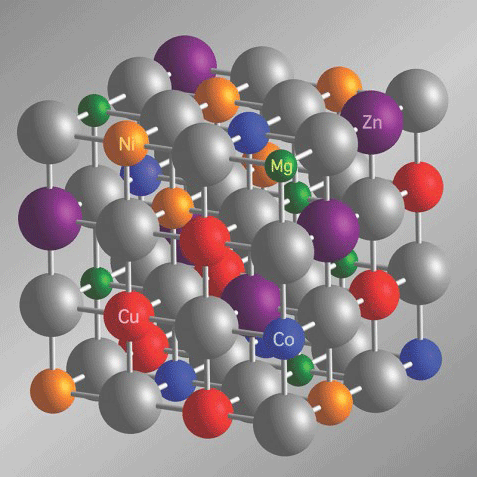A novel and intriguing class of materials? – Mini-Project 3
- sheffmaterialgirl
- Jun 11, 2016
- 3 min read
Mini-Project 3
Topic: High Entropy Alloys Duration: 6 weeks Outputs: Paper-style report, lab book & oral presentation
Hello!
Today I'll be discussing my research experience of Mini-Project 3: for our third project, our undergrad group has been lucky enough to delve into the field of a relatively new class of metallic materials known as high entropy alloys (HEAs).
In the schematic of the atomic-scale lattice below, each different colour represents a different element:
Image obtained from http://www.anl.gov/articles/researchers-create-first-entropy-stabilized-complex-oxide-alloys
HEAs have recently been the topic of intense scrutiny; if you’ve not heard of them before, these alloys are a stark contrast to alloys formed using the ‘base element’ concept; just over a decade ago, it was found that mixing 5+ principal elements in near equiatomic ratios, such as in the image above, can form alloy systems with simple crystal structures (e.g. face centred cubic and/or body centred cubic) instead of a crazy mix of brittle intermetallic compounds, as conventional alloying knowledge may predict. As a result, these HEAs exhibit desirable properties such as high temperature strength, hardness, and stability, meaning they have great potential for a multitude of applications (e.g. in the aerospace and nuclear sector). So I hope from this brief outline you can understand what a privilege it is to be working on such current research in the Department as an undergraduate!
Something I really liked about this project was that we pretty much had free rein over what alloy compositions we wanted to create – obviously we had to be able to justify what we were doing and not just wasting some expensive elements; to give you an idea, we made ‘button’ samples of just 5g in mass, yet one of the buttons alone contained over £100 of La in it. The reasoning behind some of the samples were to create refractory alloys or lightweight but strong alloys; the reasoning behind others were to see if we could blindly make a HEA. Hint: read the literature and find the parameters which an eligible composition must be defined by – don’t choose any 5 elements you like the sound of!
We melted the button samples from the alloying materials with the help of a PhD and characterised them using density measurements, optical microscopy, SEM, XRD (these acronyms are explained in Project 1), Vickers hardness tests and rolling to gauge an idea of the samples’ ductility. The sample in the picture below shows one of the buttons – is the material brittle or is it ductile but strain-rate sensitive? You tell me!

The main learning points from this project were:
Formulate a research question! Of course, no one can dispute the power of serendipity, but making some samples for the fun of it probably won’t be of much use; aim towards answering a question with some knowledge of how do it prior to getting your mitts on the materials.
Refer back to the research question in times of confusion. After exhausting – and sometimes bewildering – lab days, it can help towards regaining composure.
Get your head around the literature properly – you don’t have to write a literature review as soon as you start, but jotting down quick bullet points about papers you’ve skimmed is definitely going to come in handy later.
If you are apprehensive about your presentation, practise running through it at home with the timer tool on in Microsoft Powerpoint. You'll know how long it's taking you to complete your presentation and you'll also find out what the gaps in your knowledge are. Jot down points you want to remember to include, learn them, then run through again.
Top tip: Devise a rough plan with points to include in each section and use it for both your presentation and report – two in one! Just change the style and depth of communication.
It was a fantastic opportunity to work on something so cutting-edge and I particularly enjoyed the freedom we were granted with this project. Please let me know if you have any questions or comments about the research or undergraduate experience.
Take care and stay tuned to hear about my ultraviolet disco box! ☆
















Comments